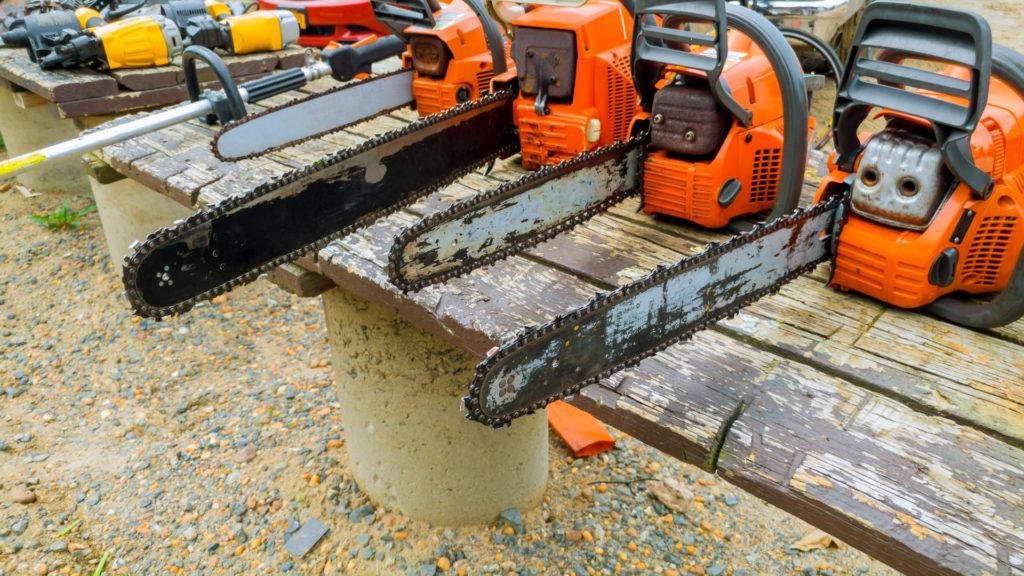The size of the chainsaw you need depends on the job that you plan to do with it. Generally, a small electric saw is suitable for light cutting tasks such as pruning trees or trimming branches. More powerful gas-powered models are better suited for larger jobs like felling trees and bucking logs.
If your intended use involves heavy-duty tasks like clearing large areas of land, then a professional grade saw with a more powerful motor would be appropriate. Safety is also an important factor when selecting the right size chainsaw; make sure you choose one that will give you adequate control over its power and speed so that you can work safely.
If you’re a homeowner looking to take on some DIY tasks around your property, chances are you’ve asked yourself the question “What size chainsaw do I need?” After all, selecting the right saw for the job can make or break your success.
The answer depends on what type of cutting and trimming work you plan to do.
Generally speaking, smaller chainsaws (14-inch models) are best suited for light pruning jobs like trimming small branches and thin trees up to 10 inches in diameter. If you’re planning bigger projects such as felling trees with diameters over 12 inches or bucking large logs into firewood chunks, then a larger saw will be required. The most popular sizes for these heavier duty jobs include 16-inch and 18-inch bars.
It’s also important to consider other factors when shopping for a new chain saw including engine power (measured in cc), weight, features like anti-vibration handles or quick-starting technology and safety features such as chain brakes or low kickback bars.

Credit: mkoutdoor.org
How Do I Know What Size Saw Chain I Need?
Choosing the right size saw chain for your chainsaw can be a tricky process. With so many different types and sizes available, it’s important to understand the critical factors that determine which type of chain will fit your saw best. The primary factor in determining what size saw chain you need is the pitch of your chainsaw bar.
The pitch refers to how far apart the drive links on the chain are spaced from one another, measured in 1/8″ increments. If you aren’t sure of your chainsaw’s pitch, consult its owner’s manual or contact the manufacturer directly for assistance.
Once you know your chainsaw’s pitch, it becomes easier to narrow down which type and size of saw chain is compatible with your machine.
Most major manufacturers offer a wide range of pitches; however, some are more common than others like 3/8″, .325″, .404″. Once you have determined what size fits your model, then all that remains is selecting a specific length and gauge (the thickness) of chain that suits well with both your project goals as well as any safety considerations related to using such an item around yourself and other people nearby when operating machinery outdoors..
How Big of a Log Can You Cut With a 14 Inch Chainsaw?
Chainsaws are an incredibly powerful tool and can be used to cut logs of many sizes. The size of log you can cut with a 14 inch chainsaw will depend on several factors, such as the type of wood, the hardness of the wood, and how sharp your saw chain is.
In general, a 14-inch chainsaw’s bar length (the distance from the tip of one tooth to the next) will allow for cutting logs up to 16 inches in diameter.
If you have access to hardwoods like oak or maple, then it might be possible to go even larger than that. However, if you’re looking at softwoods like pine or cedar, then you may need to limit yourself closer to 12 inches in diameter.
The important thing when considering what size log can be cut with a 14 inch chainsaw is making sure that your saw chain is properly maintained and sharpened so that it can safely handle large pieces of timber without becoming jammed or bogged down by resistance from knots or other irregularities within the wood itself.
What Size Tree Can You Cut With 18 Inch Chainsaw?
If you’re looking for a chainsaw that can handle larger trees, an 18-inch model may be the way to go. With the right kind of saw and operator technique, an 18″ chainsaw is capable of cutting through trees up to 36 inches in diameter.
When selecting a chainsaw size it’s important to consider both power and safety.
For safety reasons, never use a saw with more than twice the size as the tree being cut; this means if you are cutting a 24-inch tree, then use no more than an 48-inch saw. Additionally, some experts recommend always using one step down from your maximum capacity for better control and improved performance when making cuts or trimming branches from large trees.
So what should you look for when shopping around for an 18 inch chainsaw?
You’ll want to make sure it has enough power to get through tougher jobs while still providing good control over the machine; most models have between 2HP and 4HP motor output which is plenty of power for those larger logs or tree trunks.
What Size Chainsaw Do I Need to Cut Logs?
If you’re a homeowner or contractor who needs to cut logs, it’s important to understand which size chainsaw is best for the job. The size of chainsaw needed will depend on several factors including the type of wood being cut and the diameter of the log.
For small jobs like cutting firewood, a smaller model such as an electric saw with 14-16 inch bar length may be sufficient.
For heavier duty work such as felling trees or cutting large logs, a larger gas-powered saw with 18-20 inch bar length is recommended. When selecting your chainsaw, consider its power output (measured in cubic centimeters or cc) as well as its weight because those two factors can affect how easy it is to control and maneuver while working.
When choosing a chainsaw for felling trees and cutting larger logs, there are some other features that should be considered: chain pitch (the distance between drive links), chain gauge (the width of drive links), safety features like anti-kickback mechanisms, vibration dampening technology and automatic oilers.
All these features help ensure safe operation of the saw when tackling tougher jobs.
Best Chainsaw Size for a Homeowner, Rancher, Farmer, or Landowner
What Size Chainsaw Do I Need to Cut down a Tree
If you’re planning to cut down a tree, it’s important to know what size chainsaw is best for the job. Choosing the right size tool ensures that you don’t overwork yourself and can complete the task safely and efficiently.
When selecting a chainsaw, there are several factors to consider including power source, bar length, and engine displacement (cc).
The two main types of chainsaws are gas-powered or electric models. Gas-powered saws offer more cutting power but require more maintenance than electric models. Electric saws are lighter in weight and easier on your arms but may not have enough torque for larger jobs like cutting down trees.
The bar length refers to how long the guide bar is – this will determine how thick of a log it can handle before stalling out or becoming too difficult to control. Generally speaking, an 8 inch bar will be adequate when felling trees up to 12 inches in diameter; however if you need something larger then look for one with a 10-14 inch guidebar instead.
Conclusion
Choosing the right size chainsaw can be confusing, especially if you’re a beginner. To make it easier, here are some things to consider when deciding on what size chainsaw is best for you.
First and foremost, think about the tasks that you plan to do with your chainsaw.
If you’re only going to use it occasionally for light projects like pruning or cutting firewood, then an electric model with a smaller bar length (up to 16 inches) should suffice. However, if you’re planning on doing more demanding work such as felling trees or clearing large amounts of brush and debris, then a gas-powered saw with 18-24 inch bar length will be ideal for these kinds of jobs.
Next up is considering how much power your new saw needs in order to get the job done efficiently and safely.
Generally speaking, larger engines provide more power so if you plan on tackling tougher projects like bucking logs or cutting thick branches then look for something with higher displacement (cc).
Table of Contents

